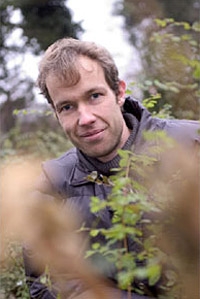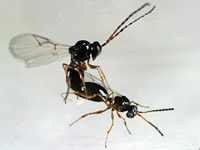
The evolutionary added value of sex
Asexual procreation in female wasps leads to an accumulation of genetic mutations, and the shrivelling of their sex organ. Leiden biologist Ken Kraaijeveld published this discovery in Evolution. His research is one of the first experimental studies into the consequences of asexual procreation.

Asexual procreation
Procreation without the intervention of a male: for many plant and animal species this is an efficient way of producing large numbers of progeny rapidly. The question is then, what is the value of sexual procreation? Evolution biologists have long speculated on the possible negative consequences of asexual procreation, but for Kraaijeveld theorising is not enough. 'Experimental studies are necessary if you want to know what the real situation is.'
Wasp
Kraaijeveld's research shows what happens when a species moves to asexual procreation for an extended period of time. Kraaijeveld, a biologist, has conducted research for many years on the wasp Leptopilina clavipes, found in sandy areas in the Netherlands. In Northern Europe this wasp has been infected with a bacteria for the past 50,000 to 100,000 years. The females lay eggs, which only produce females, without the intervention of male fertilisation.
Sperm storage

Kraaijeveld paired the asexual females in the Dutch pairs with males from Spain that were not infected with the bacteria. The asexual females were unable to store more sperm, which virtually means that no fertilisation took place. This was precisely the kind of result that Kraaijeveld expected: 'In asexual populations you expect that all the characteristics related to sexuality are no longer exposed to natural selection, so mutations can accumulate undisturbed. In this case the organ for sperm storage shrivelled.'
Attractive
Kraaijeveld's mating experiments showed that the Spanish males did not find the asexual females from the Netherlands at all attractive. The asexual females emit unusual odours experienced by the Spanish males as unpleasant. However, Kraaijeveld discovered that this is unrelated to their asexuality. When he cured them of their infection using antibiotics so that they again produced male offspring, these young Dutch males proved to have a preference for asexual females. It is not the case that asexuality is by definition unattraactive. According to Kraaijeveld, ‘Spanish males reject asexual females from the Netherlands because they prefer to have a partner from their own population. Dutch males in their turn prefer Dutch females. These partner choices probably arose in the time that the Dutch wasps still engaged in sexual procreation.'
Extinct
The Dutch female wasps remain totally dependent on asexual procreation for their survival. Kraaijeveld is curious whether they will in time become extinct as a result of the accumulation of harmful mutations. 'Mutations might accumulate, for example, in characteristics that protect against disease. At a given point in time, this will cause a species to die out.' This would confirm the evolutionary added value of sexual procreation. Maybe males are not redundant, after all.
Ken Kraaijeveld was awarded a Veni subsidy from NWO for this research in 2005.
Ken Kraaijeveld, Padu Franco, Barbara M. Reumer, and Jacques J. M. van Alphen
Effects of parthenogenesis and geographic isolation on female sexual traits in a parasitoid wasp
In: Evolution, online early view November 2009
Previous Newsletter articles
Het nut van mannen (10 January 2006)
